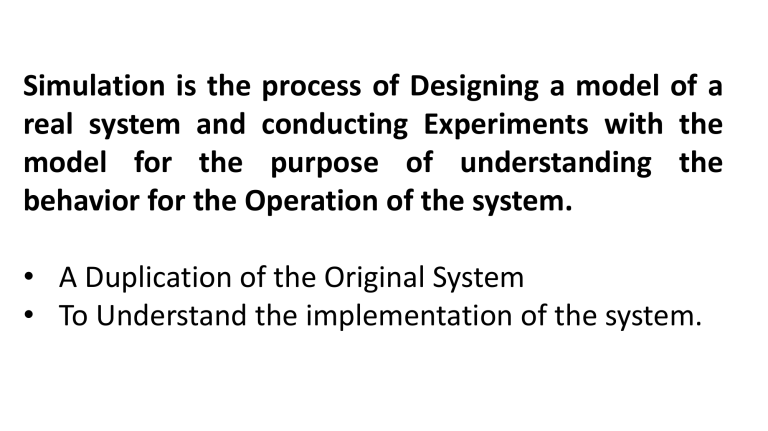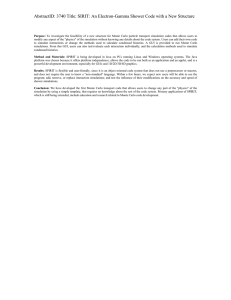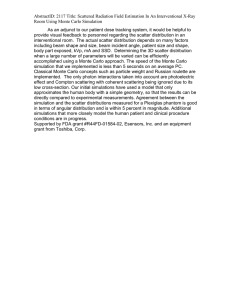
Simulation is the process of Designing a model of a real system and conducting Experiments with the model for the purpose of understanding the behavior for the Operation of the system. • A Duplication of the Original System • To Understand the implementation of the system. This Method is used by various types of organization for there different uses. Like. a) As per different Business situation. b) For inventory control c) Financial decision etc Monte Carlo simulation is a computerized mathematical technique that allows people to account for risk in quantitative analysis and decision making. The technique is used by professionals in such widely disparate fields as finance, project management, energy, manufacturing, engineering, research and development, insurance, oil & gas, transportation, and the environment. Monte Carlo simulation furnishes the decision-maker with a range of possible outcomes and the probabilities they will occur for any choice of action.. It shows the extreme possibilities—the outcomes of going for broke and for the most conservative decision—along with all possible consequences for middle-ofthe-road decisions. The technique was first used by scientists working on the atom bomb; it was named for Monte Carlo, the Monaco resort town renowned for its casinos. Since its introduction in World War II, Monte Carlo simulation has been used to model a variety of physical and conceptual systems. Simulation in Quantitative techniques Monte Carlo simulation performs risk analysis by building models of possible results by substituting a range of values—a probability distribution—for any factor that has inherent uncertainty. It then calculates results over and over, each time using a different set of random values from the probability functions. Depending upon the number of uncertainties and the ranges specified for them, a Monte Carlo simulation could involve thousands or tens of thousands of recalculations before it is complete. Monte Carlo simulation produces distributions of possible outcome values. By using probability distributions, variables can have different probabilities of different outcomes occurring. Probability distributions are a much more realistic way of describing uncertainty in variables of a risk analysis. Common probability distributions include: Normal – Or “bell curve.” The user simply defines the mean or expected value and a standard deviation to describe the variation about the mean. Values in the middle near the mean are most likely to occur. It is symmetric and describes many natural phenomena such as people’s heights. Examples of variables described by normal distributions include inflation rates and energy prices. Lognormal – Values are positively skewed, not symmetric like a normal distribution. It is used to represent values that don’t go below zero but have unlimited positive potential. Examples of variables described by lognormal distributions include real estate property values, stock prices, and oil reserves. Uniform – All values have an equal chance of occurring, and the user simply defines the minimum and maximum. Examples of variables that could be uniformly distributed include manufacturing costs or future sales revenues for a new product. Triangular – The user defines the minimum, most likely, and maximum values. Values around the most likely are more likely to occur. Variables that could be described by a triangular distribution include past sales history per unit of time and inventory levels. PERT- The user defines the minimum, most likely, and maximum values, just like the triangular distribution. Values around the most likely are more likely to occur. However values between the most likely and extremes are more likely to occur than the triangular; that is, the extremes are not as emphasized. An example of the use of a PERT distribution is to describe the duration of a task in a project management model. Discrete – The user defines specific values that may occur and the likelihood of each. An example might be the results of a lawsuit: 20% chance of positive verdict, 30% change of negative verdict, 40% chance of settlement, and 10% chance of mistrial. During a Monte Carlo simulation, values are sampled at random from the input probability distributions. Each set of samples is called an iteration, and the resulting outcome from that sample is recorded. Monte Carlo simulation does this hundreds or thousands of times, and the result is a probability distribution of possible outcomes. In this way, Monte Carlo simulation provides a much more comprehensive view of what may happen. It tells you not only what could happen, but how likely it is to happen. Monte Carlo simulation provides a number of advantages over deterministic, or “singlepoint estimate” analysis: •Probabilistic Results: Results show not only what could happen, but how likely each outcome is. •Graphical Results: Because of the data a Monte Carlo simulation generates, it’s easy to create graphs of different outcomes and their chances of occurrence. This is important for communicating findings to other stakeholders. •Sensitivity Analysis: With just a few cases, deterministic analysis makes it difficult to see which variables impact the outcome the most. In Monte Carlo simulation, it’s easy to see which inputs had the biggest effect on bottom-line results. •Scenario Analysis: In deterministic models, it’s very difficult to model different combinations of values for different inputs to see the effects of truly different scenarios. Using Monte Carlo simulation, analysts can see exactly which inputs had which values together when certain outcomes occurred. This is invaluable for pursuing further analysis. •Correlation of Inputs: In Monte Carlo simulation, it’s possible to model interdependent relationships between input variables. It’s important for accuracy to represent how, in reality, when some factors go up, others go up or down accordingly. Procedure for Monte Carlo Simulation: Step 1: Establish a probability distribution for the variables to be analyzed. Step 2: Find the cumulative probability distribution for each variable. Step 3: Set Random Number intervals for variables and generate random numbers. Step 4: Simulate the experiment by selecting random numbers from random numbers tables until the required number of simulations are generated. Step 5: Examine the results and validate the model. Example : Dr. Strong, a dentist schedules all his patients for 30 minute appointments. Some of the patients take more or less than 30 minutes depending on the type of dental work to be done. The following table shows the summary of the various categories of work, their probabilities and the time actually needed to complete the work. Simulate the dentist’s clinic for four hours and determine the average waiting time for the patients as well as the idleness of the doctor. Assume that all the patients show up at the clinic exactly at their scheduled arrival time, starting at 8.00 am. Use the following random numbers for handling the above problem: Procedure for Monte Carlo Simulation: Step 1: Establish a probability distribution for the variables to be analyzed. Step 2: Find the cumulative probability distribution for each variable. Step 3: Set Random Number intervals for variables and generate random numbers. Step 4: Simulate the experiment by selecting random numbers from random numbers tables until the required number of simulations are generated. Step 5: Examine the results and validate the model.





